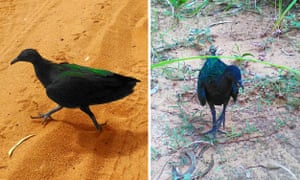A rainbow-coloured pigeon native to islands in the Indian and Pacific
oceans has been found on the Australian mainland for the first time, by
Indigenous rangers working near Broome.
The Nicobar pigeon, Caloenas nicobarica, the closest living relative to the dodo, is named for India’s Nicobar Islands, more than 4,000km north of Broome.
Its range extends east from those islands across Malaysia and Thailand to the Solomon Islands. Until it was spotted by a team of Bardi Jawa rangers on the Dampier Peninsula near One Arm Point, an Indigenous community 215km north of Broome, the closest it had been found to the Australian mainland was a lone bird sighted on an oil rig in the Timor Sea in 1989.
“They saw it walking across the road about 1,600m away from the Chile Creek community,” Bardi Jawa men’s rangers coordinator Phillip “Bibido” McCarthy said, naming a small seasonal community about 10km from both One Arm Point and Lombadina. “Having grown up around here, and knowing all the birds that are around here, they could tell that this was not an Australian animal.”
The rangers took a quick photo of the animal on their phone and sent it to McCarthy, who sent it on to the Western Australian authorities.
That was several weeks ago. Since then, there have been a number of
other sightings, McCarthy said, with enough differences in the shading
of its grey feathers and iridescent rainbow wings to suggest that at
least two individuals had taken a sojourn on the Kimberley coastline.
Some have been spotted pecking at native fruit, plentiful after the wet season, while others appear to be foraging on seeds.
On Monday, a Nicobar pigeon was captured in the front yard of a house in One Arm point and taken to the rangers’ offices, where it escaped its carry basket and flew around the office before being picked up by the WA department of agriculture. It will be placed in quarantine in Perth while authorities decide what to do with it.
McCarthy got a good look at the bird as it flapped over the cubicles and said it looked to be the same size as a homing pigeon, only prettier.
“This is the first sighting of it on mainland Australia,” he told Guardian Australia. “We know it has come a long way so it’s quite unique to find it here. We have absolutely no idea how it got here.”
He said the discovery highlighted the importance of Indigenous rangers, who had the local knowledge and training to recognise and record the interloper.
The Nicobar pigeon is classified as near threatened on the International Union for the Conservation of Nature red list. Rainforest clearing in its native islands have prompted population decline but its range is so vast that there is no accurate estimate of the wild population.
The Nicobar pigeon, Caloenas nicobarica, the closest living relative to the dodo, is named for India’s Nicobar Islands, more than 4,000km north of Broome.
Its range extends east from those islands across Malaysia and Thailand to the Solomon Islands. Until it was spotted by a team of Bardi Jawa rangers on the Dampier Peninsula near One Arm Point, an Indigenous community 215km north of Broome, the closest it had been found to the Australian mainland was a lone bird sighted on an oil rig in the Timor Sea in 1989.
“They saw it walking across the road about 1,600m away from the Chile Creek community,” Bardi Jawa men’s rangers coordinator Phillip “Bibido” McCarthy said, naming a small seasonal community about 10km from both One Arm Point and Lombadina. “Having grown up around here, and knowing all the birds that are around here, they could tell that this was not an Australian animal.”
The rangers took a quick photo of the animal on their phone and sent it to McCarthy, who sent it on to the Western Australian authorities.
Some have been spotted pecking at native fruit, plentiful after the wet season, while others appear to be foraging on seeds.
On Monday, a Nicobar pigeon was captured in the front yard of a house in One Arm point and taken to the rangers’ offices, where it escaped its carry basket and flew around the office before being picked up by the WA department of agriculture. It will be placed in quarantine in Perth while authorities decide what to do with it.
McCarthy got a good look at the bird as it flapped over the cubicles and said it looked to be the same size as a homing pigeon, only prettier.
“This is the first sighting of it on mainland Australia,” he told Guardian Australia. “We know it has come a long way so it’s quite unique to find it here. We have absolutely no idea how it got here.”
He said the discovery highlighted the importance of Indigenous rangers, who had the local knowledge and training to recognise and record the interloper.
The Nicobar pigeon is classified as near threatened on the International Union for the Conservation of Nature red list. Rainforest clearing in its native islands have prompted population decline but its range is so vast that there is no accurate estimate of the wild population.

No comments:
Post a Comment